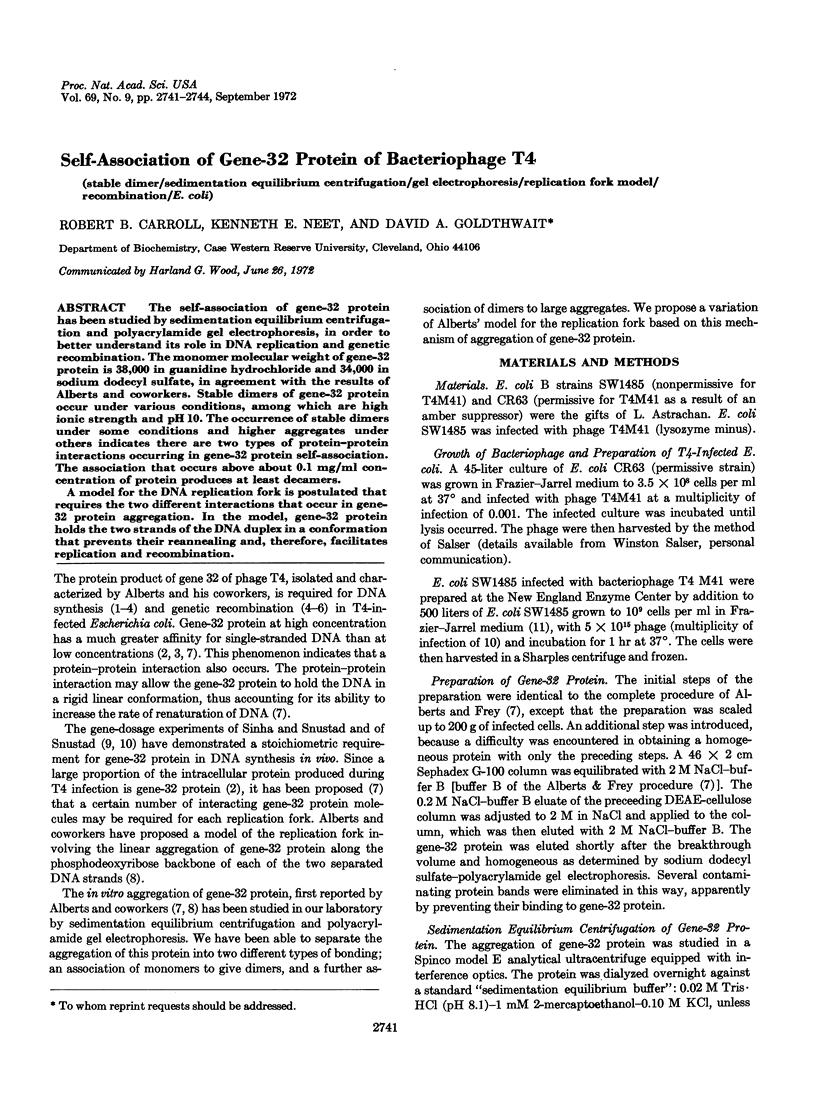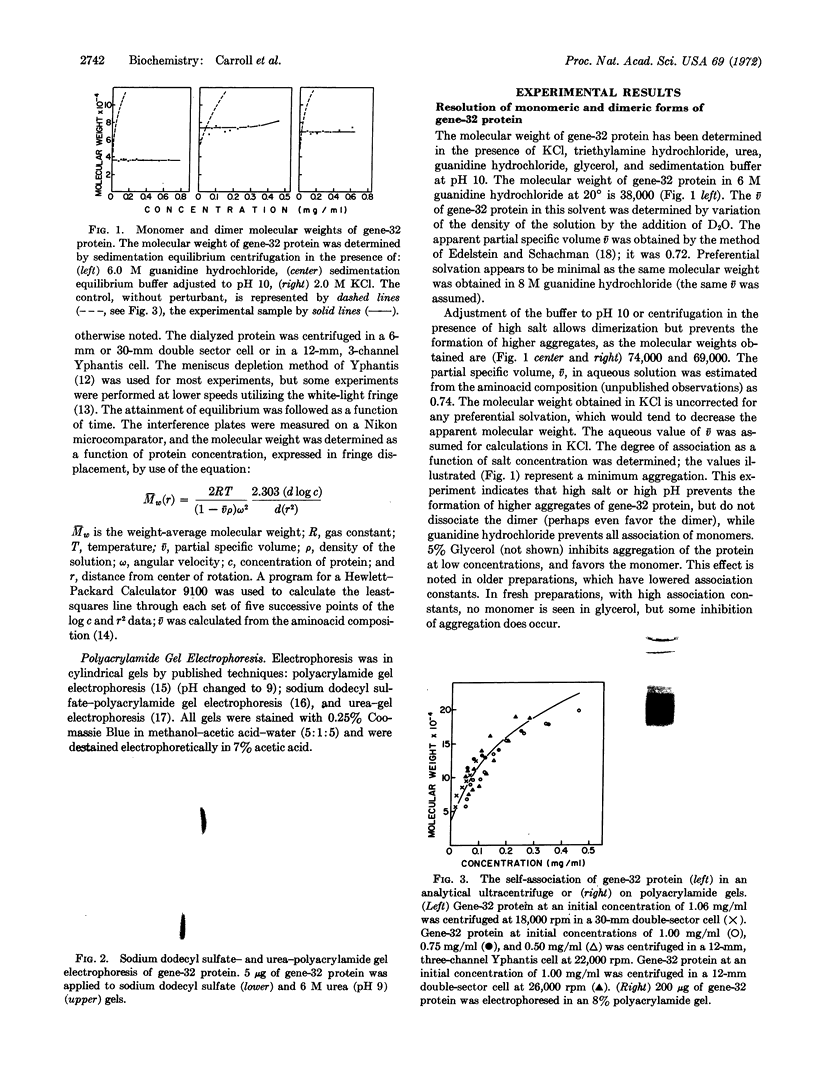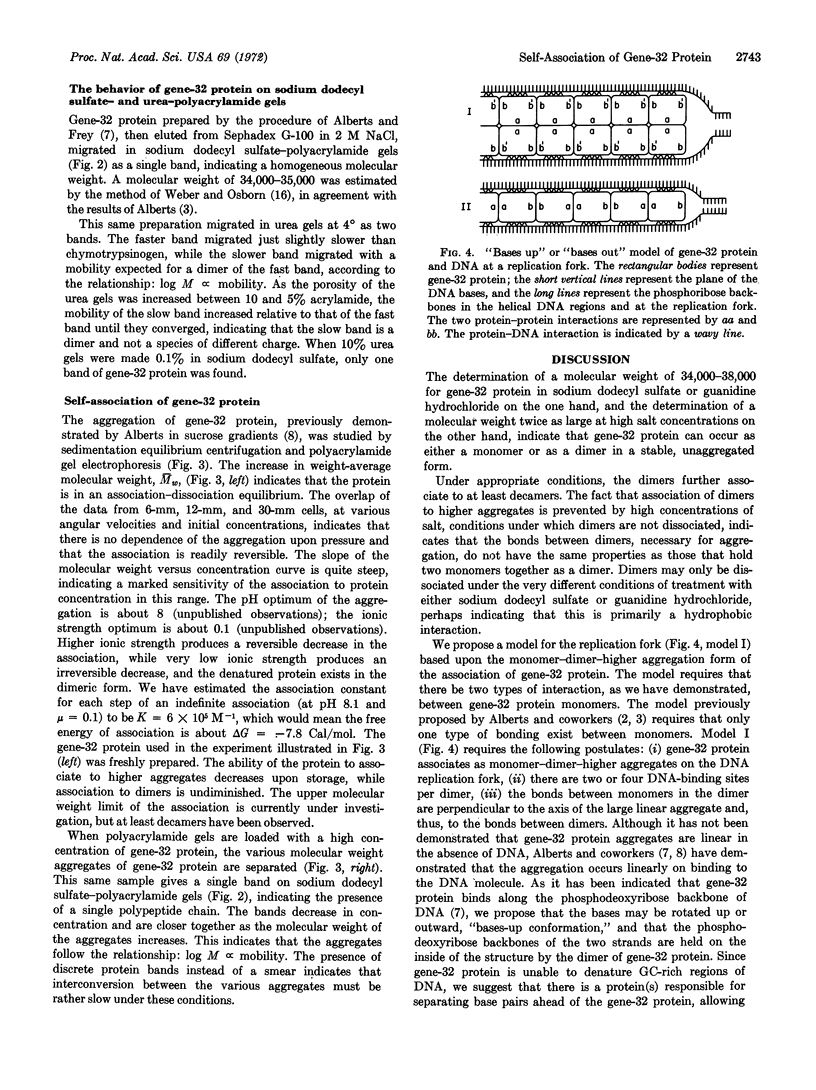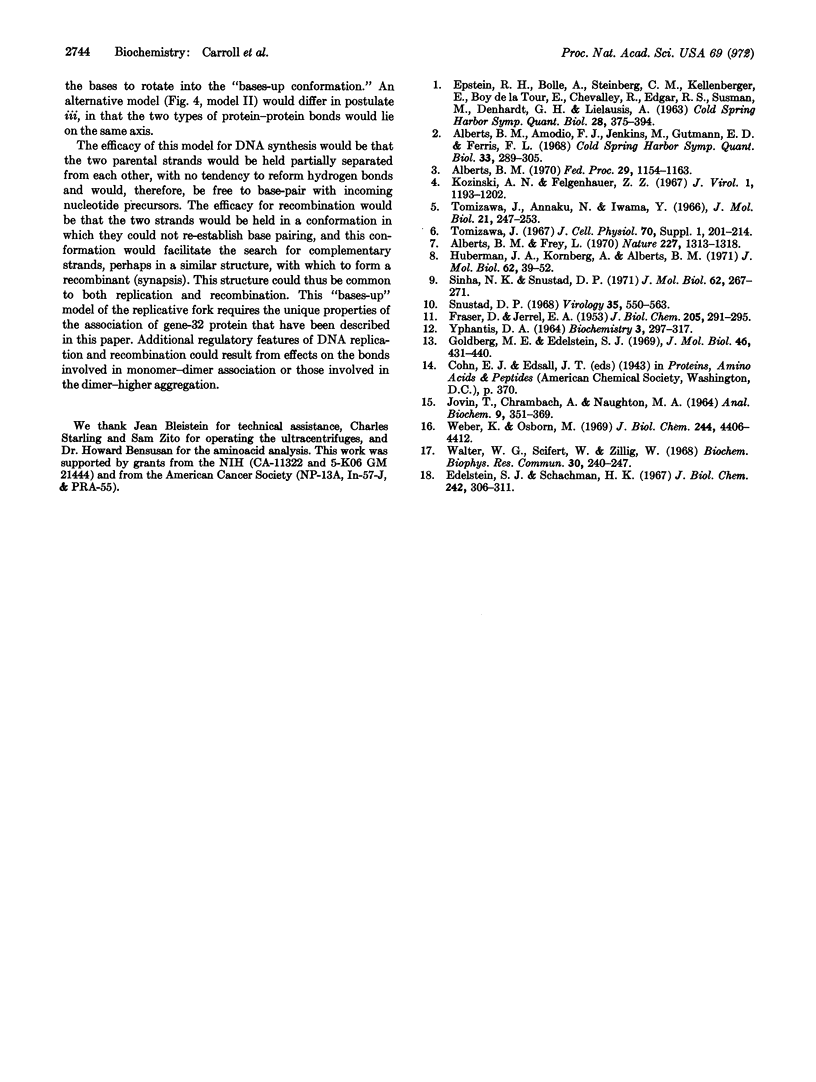Abstract
The self-association of gene-32 protein has been studied by sedimentation equilibrium centrifugation and polyacrylamide gel electrophoresis, in order to better understand its role in DNA replication and genetic recombination. The monomer molecular weight of gene-32 protein is 38,000 in guanidine hydrochloride and 34,000 in sodium dodecyl sulfate, in agreement with the results of Alberts and coworkers. Stable dimers of gene-32 protein occur under various conditions, among which are high ionic strength and pH 10. The occurrence of stable dimers under some conditions and higher aggregates under others indicates there are two types of protein-protein interactions occurring in gene-32 protein self-association. The association that occurs above about 0.1 mg/ml concentration of protein produces at least decamers.
A model for the DNA replication fork is postulated that requires the two different interactions that occur in gene-32 protein aggregation. In the model, gene-32 protein holds the two strands of the DNA duplex in a conformation that prevents their reannealing and, therefore, facilitates replication and recombination.
Keywords: stable dimer, sedimentation equilibrium centrifugation, gel electrophoresis, replication fork model, recombination, E. coli
Full text
PDF



Images in this article
Selected References
These references are in PubMed. This may not be the complete list of references from this article.
- Alberts B. M., Amodio F. J., Jenkins M., Gutmann E. D., Ferris F. L. Studies with DNA-cellulose chromatography. I. DNA-binding proteins from Escherichia coli. Cold Spring Harb Symp Quant Biol. 1968;33:289–305. doi: 10.1101/sqb.1968.033.01.033. [DOI] [PubMed] [Google Scholar]
- Alberts B. M., Frey L. T4 bacteriophage gene 32: a structural protein in the replication and recombination of DNA. Nature. 1970 Sep 26;227(5265):1313–1318. doi: 10.1038/2271313a0. [DOI] [PubMed] [Google Scholar]
- Alberts B. M. Function of gene 32-protein, a new protein essential for the genetic recombination and replication of T4 bacteriophage DNA. Fed Proc. 1970 May-Jun;29(3):1154–1163. [PubMed] [Google Scholar]
- Edelstein S. J., Schachman H. K. The simultaneous determination of partial specific volumes and molecular weights with microgram quantities. J Biol Chem. 1967 Jan 25;242(2):306–311. [PubMed] [Google Scholar]
- FRASER D., JERREL E. A. The amino acid composition of T3 bacteriophage. J Biol Chem. 1953 Nov;205(1):291–295. [PubMed] [Google Scholar]
- Goldberg M. E., Edelstein S. J. Sedimentation equilibrium of paucidisperse systems. Subunit structure of complemented beta-galactosidase. J Mol Biol. 1969 Dec 28;46(3):431–440. doi: 10.1016/0022-2836(69)90186-7. [DOI] [PubMed] [Google Scholar]
- Huberman J. A., Kornberg A., Alberts B. M. Stimulation of T4 bacteriophage DNA polymerase by the protein product of T4 gene 32. J Mol Biol. 1971 Nov 28;62(1):39–52. doi: 10.1016/0022-2836(71)90129-x. [DOI] [PubMed] [Google Scholar]
- JOVIN T., CHRAMBACH A., NAUGHTON M. A. AN APPARATUS FOR PREPARATIVE TEMPERATURE-REGULATED POLYACRYLAMIDE GEL ELECTROPHORESIS. Anal Biochem. 1964 Nov;9:351–369. doi: 10.1016/0003-2697(64)90192-7. [DOI] [PubMed] [Google Scholar]
- Kozinski A. W., Felgenhauer Z. Z. Molecular recombination in T4 bacteriophage deoxyribonucleic acid. II. Single-strand breaks and exposure of uncomplemented areas as a prerequisite for recombination. J Virol. 1967 Dec;1(6):1193–1202. doi: 10.1128/jvi.1.6.1193-1202.1967. [DOI] [PMC free article] [PubMed] [Google Scholar]
- Sinha N. K., Snustad D. P. DNA synthesis in bacteriophage T4-infected Escherichia coli: evidence supporting a stoichiometric role for gene 32-product. J Mol Biol. 1971 Nov 28;62(1):267–271. doi: 10.1016/0022-2836(71)90145-8. [DOI] [PubMed] [Google Scholar]
- Snustad D. P. Dominance interactions in Escherichia coli cells mixedly infected with bacteriophage T4D wild-type and amber mutants and their possible implications as to type of gene-product function: catalytic vs. stoichiometric. Virology. 1968 Aug;35(4):550–563. doi: 10.1016/0042-6822(68)90285-7. [DOI] [PubMed] [Google Scholar]
- Tomizawa J. I., Anraku N., Iwama Y. Molecular mechanisms of genetic recombination in bacteriophage. VI. A mutant defective in the joining of DNA molecules. J Mol Biol. 1966 Nov 14;21(2):247–253. doi: 10.1016/0022-2836(66)90095-7. [DOI] [PubMed] [Google Scholar]
- Tomizawa J. I. Molecular mechanisms of genetic recombination in bacteriophage: joint molecules and their conversion to recombinant molecules. J Cell Physiol. 1967 Oct;70(2 Suppl):201–213. doi: 10.1002/jcp.1040700414. [DOI] [PubMed] [Google Scholar]
- Walter G., Seifert W., Zillig W. Modified DNA-dependent RNA polymerase from E. coli infected with bacteriophage T4. Biochem Biophys Res Commun. 1968 Feb 15;30(3):240–247. doi: 10.1016/0006-291x(68)90441-5. [DOI] [PubMed] [Google Scholar]
- Weber K., Osborn M. The reliability of molecular weight determinations by dodecyl sulfate-polyacrylamide gel electrophoresis. J Biol Chem. 1969 Aug 25;244(16):4406–4412. [PubMed] [Google Scholar]
- YPHANTIS D. A. EQUILIBRIUM ULTRACENTRIFUGATION OF DILUTE SOLUTIONS. Biochemistry. 1964 Mar;3:297–317. doi: 10.1021/bi00891a003. [DOI] [PubMed] [Google Scholar]




